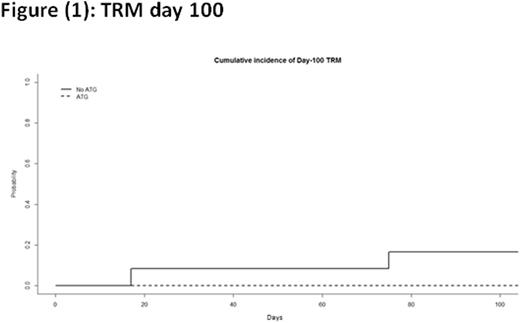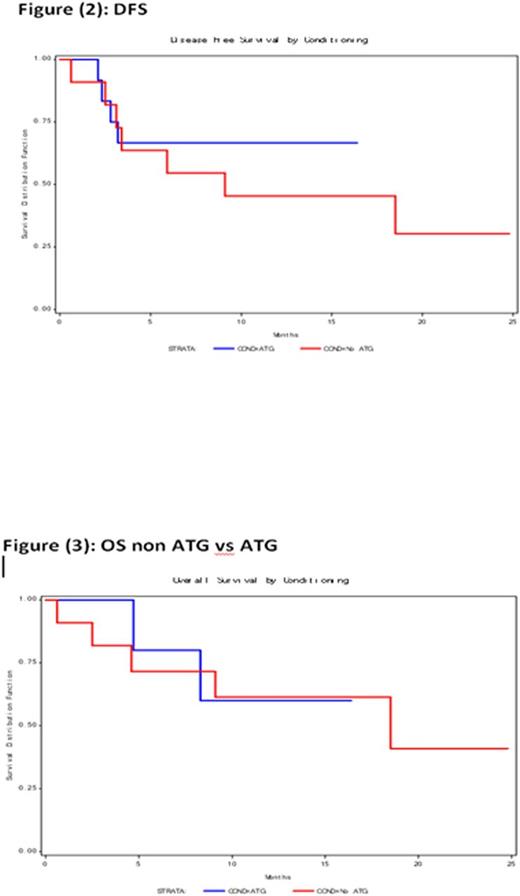Abstract
Introduction: The use of a Myeloablative (MA) regimen followed bypost-transplantation high dose Cyclophosphamide (PT-CY) has been adopted to overcome the increased relapse risk following nonmyeloablative conditioning regimen and unmanipulated Haploidentical Bone Marrow Transplantation, in patients with high-risk hematological malignancies, with acceptable TRM and risk of GVHD. We added ATG to our Myeloablative regimen with PT-CY after noticing significant incidence of grade II-IV aGVHD with the first few cases. Here we compare the outcomes of the 12 patients who received ATG to the outcomes of the first 11 patients who were transplanted without ATG.
Patients and Methods: our haploidentical program was started in 2013 as a phase I/II prospective clinical trial. After reviewing the first 11 cases enrolled on the trial (MA regimen with PT-CY, without ATG), we noticed significant incidence of high grade aGVHD (54.55%). We amended our protocol in early 2015. Rabbit ATG was added at a dose of 3 mg/kg (1.5 mg/kg day -3 and day -2) to our conditioning regimen [thiotepa (5mg/kg/day on day -8 and -7), busulfan (3.2mg/kg/day IV day-6, -5 and -4), fludarabine (50mg/m2/day on day -6, -5 and -4 )] or [TBI 1000 cGy (200cGy twice a day on days -10, -9 and one dose on day -8), fludarabine (30mg/m2/day on Days -7, -6, -5 and -4)]. Graft-versus-host disease (GVHD) prophylaxis consisted of PT-CY (50mg/kg/day) on days +3 and +5, cyclosporine (starting day +4), and mycophenolate mofetil (starting day +1). Table 1 summarizes the disease-type and disease-status at transplant. Patient characteristics were comparable at baseline between the 2 groups.
Results (Table 2): We enrolled patients with high risk hematologic malignancies in need for SCT but have no matched donor (MSD, MUD). Despite the small sample size, our results showed a statistically significant difference in the rate of acute GVHD between the 2 groups (p= 0.0161) in favor of the ATG group, chronic GVHD was more frequent in the non-ATG group however the difference did not reach statistical significance probably due to the small sample size. There was no statistically-significant difference in the risk of relapse, CMV reactivation or Hemorrhagic cystitis between the 2 groups. However, there was a trend of higher relapse rate (33.3% vs 18.18%), a higher rate of Hemorrhagic cystitis (50% vs 18.18%) and a higher rate of CMV reactivation (100% vs 81.82%) in the ATG group. The cumulative incidence of TRM at day 100 was in favor of the ATG group (figure 1), with a trend toward a better DFS in these patients 6 months post-transplant (figure 2). To be noted the follow up period was shorter for the ATG group because ATG was added later on. Figure 3 shows the survival for ATG vs non ATG group.
Conclusion: The use of ATG with myeloablative Haplo conditioning can significantly reduce the risk of acute GVHD and early TRM. We have seen more relapses, higher rate of CMV reactivation, and hemorrhagic cystitis with the addition of ATG but these did not reach statistical significance probably due to the small sample size. A lower dose of ATG might be the way to go to strike a careful balance and improve the outcomes of myeloablative haploidentical transplant.
No relevant conflicts of interest to declare.
Author notes
Asterisk with author names denotes non-ASH members.




